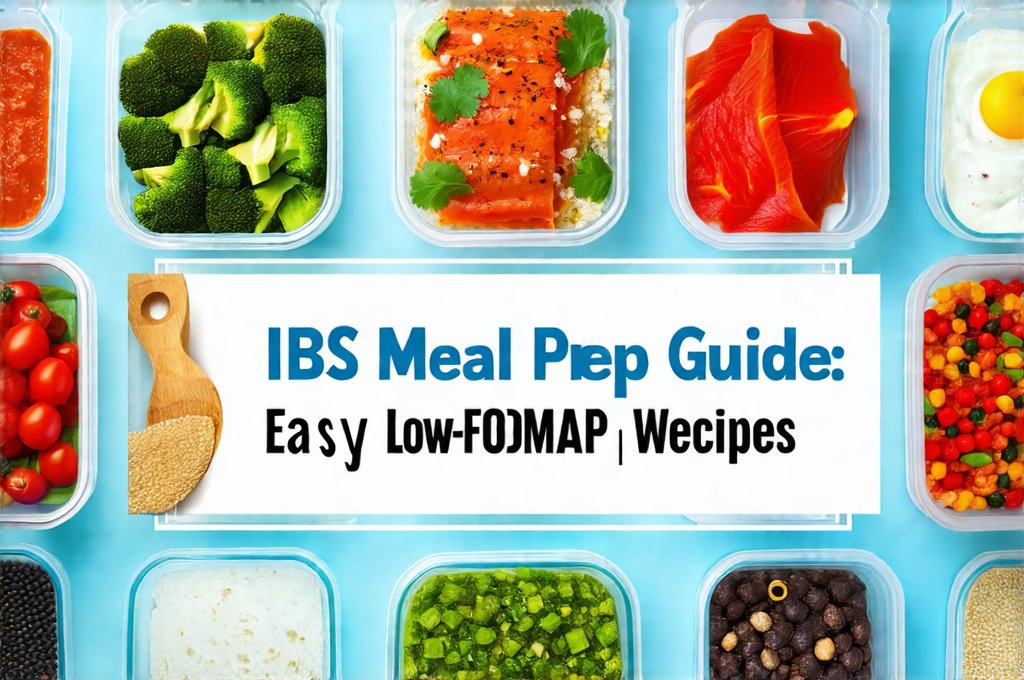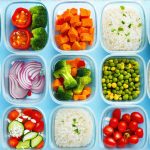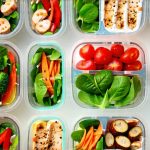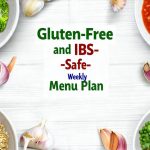Irritable Bowel Syndrome (IBS) can significantly impact daily life, often forcing individuals to navigate a minefield of dietary restrictions and unpredictable symptoms. Many people with IBS find that specific foods exacerbate their condition, leading to bloating, gas, abdominal pain, and changes in bowel habits. While there’s no one-size-fits-all diet for IBS, the low-FODMAP diet has proven remarkably effective for many sufferers. This dietary approach focuses on limiting fermentable oligosaccharides, disaccharides, monosaccharides, and polyols – essentially, sugars that are poorly absorbed by the small intestine and then fermented by bacteria in the large bowel, triggering those unpleasant IBS symptoms. However, adhering to a low-FODMAP diet can be challenging, requiring careful planning and a deep understanding of food ingredients.
That’s where meal prepping comes in. Taking control of your meals is arguably the most powerful tool you have when managing IBS through diet. It allows you to eliminate guesswork, avoid accidental triggers, and ensure that nourishing, gut-friendly foods are readily available whenever hunger strikes. This isn’t about restrictive dieting; it’s about empowering yourself with knowledge and preparing for success. By proactively planning your meals around low-FODMAP ingredients, you can reclaim control over your digestive health and enjoy a wider range of delicious, satisfying foods without fear of flare-ups. The following guide will provide practical strategies and easy weekly recipes to help you navigate IBS meal prep effectively. You might even find that meal prep as a grounding tool helps with the mental aspects of managing your condition, too.
Understanding the Low-FODMAP Diet for Meal Prep
The low-FODMAP diet isn’t necessarily a long-term solution for everyone, but it’s an incredibly useful tool for identifying individual trigger foods. Typically, it involves three phases: elimination, reintroduction, and personalization. The elimination phase is the most restrictive, where you remove high-FODMAP foods for 2-6 weeks to allow your gut to calm down. This is followed by a reintroduction phase, where you systematically add individual FODMAP groups back into your diet, one at a time, to identify which ones cause symptoms. Finally, personalization involves tailoring the diet to your specific tolerances and creating a sustainable long-term eating plan. Meal prepping is particularly valuable during the elimination and reintroduction phases because it requires meticulous attention to ingredients. If you’re starting from scratch, creating a weekly gut-healthy meal plan can be a great place to begin.
Successful low-FODMAP meal prep relies on knowing which foods are safe and which should be avoided. Some readily available low-FODMAP options include lactose-free dairy (or alternatives like almond milk), rice, oats (in moderation), quinoa, potatoes, carrots, spinach, blueberries, strawberries, oranges, and lean proteins like chicken and fish. Conversely, high-FODMAP foods to avoid during the elimination phase include onions, garlic, apples, pears, mangoes, honey, wheat, rye, beans, lentils, milk (unless lactose-free), yogurt, and many processed foods containing hidden FODMAPs. Always double-check ingredient lists – even seemingly safe products can contain high-FODMAP additives. Resources like the Monash University Low-FODMAP Diet app are invaluable for accurate information and up-to-date food listings.
The key to stress-free meal prepping is organization. Start by creating a weekly menu based on low-FODMAP recipes, then make a detailed shopping list. Batch cooking – preparing large quantities of staple ingredients like rice, quinoa, or roasted vegetables – can save significant time during the week. Store prepped foods in airtight containers in the refrigerator for easy access. Finally, don’t be afraid to experiment with flavor! Low-FODMAP doesn’t have to mean bland food; herbs, spices, and lactose-free alternatives can add delicious depth and complexity to your meals. To further simplify things, consider balanced weekly meal plans that minimize overlap and maximize nutrient diversity.
A Sample Weekly Meal Prep Plan
This sample meal plan focuses on simplicity and versatility, making it easy to adapt to your individual preferences. It includes breakfast, lunch, dinner, and snack ideas – all low-FODMAP compliant. Remember to adjust portion sizes based on your own needs and activity level.
Breakfast (Prep once for the week): Overnight Oats made with lactose-free milk or almond milk, blueberries, and a sprinkle of chia seeds. Prepare in individual jars for grab-and-go convenience.
Lunch (Prep Sunday & Wednesday): Large batch of quinoa salad with shredded chicken breast, chopped carrots, spinach, cucumber, and a lemon-tahini dressing. Divide into containers for easy lunches on Monday, Tuesday, and Wednesday. Repeat on Sunday for the remainder of the week.
Dinner (Prep twice weekly): Baked salmon with roasted potatoes and steamed green beans. Another option: Chicken stir-fry with rice noodles and low-FODMAP vegetables like bell peppers and bok choy. Batch cook large portions to minimize daily cooking time.
Snacks: Rice cakes with peanut butter, a handful of strawberries, or lactose-free yogurt.
This is just a starting point; feel free to swap out ingredients and recipes based on your own preferences and tolerances. The goal is to create a sustainable meal prep routine that supports your digestive health and makes managing IBS easier. Remember to prioritize whole, unprocessed foods whenever possible. You can also learn how to create a weekly GERD meal prep plan which has similar principles for dietary management.
Creating Low-FODMAP Breakfasts
Breakfast can be tricky on a low-FODMAP diet, as many traditional options contain high-FODMAP ingredients. Oats are generally well-tolerated in moderate amounts, but portion control is key. Overnight oats are an excellent choice because they require minimal morning preparation and can be customized with low-FODMAP toppings. Consider using lactose-free milk or almond milk instead of dairy milk, and add blueberries, strawberries, chia seeds, or a sprinkle of cinnamon for flavor. Avoid honey or maple syrup, as these are high in FODMAPs.
Another great option is scrambled eggs with spinach and a side of gluten-free toast. Eggs are naturally low-FODMAP and provide a good source of protein to keep you feeling full and satisfied. If you’re craving something sweeter, try a smoothie made with lactose-free yogurt, strawberries, banana (in small amounts), and almond milk. Be mindful of the portion size of banana, as it’s higher in FODMAPs than other fruits.
Quick & Easy Low-FODMAP Lunches
Lunches often pose a challenge when you’re on the go, making prepped meals essential for staying on track with your diet. Quinoa salads are incredibly versatile and can be customized with various low-FODMAP ingredients. Add shredded chicken or fish for protein, along with chopped vegetables like carrots, cucumber, spinach, and bell peppers. A lemon-tahini dressing provides a flavorful and healthy finishing touch.
Another convenient option is a rice noodle salad with shrimp or tofu, seasoned with ginger and soy sauce (ensure it’s gluten-free). Avoid onions and garlic in the marinade. Pre-portioned containers of leftovers from dinner are also a great lunch solution, saving you time and effort during the week. Focus on building balanced meals that include protein, carbohydrates, and healthy fats to provide sustained energy throughout the afternoon. To reduce waste while prepping, consider these meal prep ideas.
Delicious Low-FODMAP Dinners
Dinner is where you can get creative with your low-FODMAP cooking. Baked salmon with roasted potatoes and steamed green beans is a classic combination that’s both nutritious and delicious. Salmon is rich in omega-3 fatty acids, which have anti-inflammatory properties that may benefit gut health. Use olive oil for roasting the potatoes and season them with herbs like rosemary or thyme.
Chicken stir-fry with rice noodles is another excellent choice. Use low-FODMAP vegetables like bell peppers, bok choy, and carrots, and season with ginger, soy sauce (gluten-free), and a touch of chili flakes for spice. Avoid onions and garlic in the stir-fry sauce. Remember to cook your rice noodles according to package directions and drain them thoroughly before adding them to the stir-fry. Experiment with different spices and herbs to add flavor and variety to your meals. If you are looking for simpler options, explore one-pot meals that minimize cleanup and maximize flavor. Also, don’t forget the importance of good kitchen arrangements for efficient meal preparation.


















